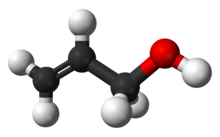Allyl alcohol

| |

| |
| Names | |
|---|---|
| Preferred IUPAC name
Prop-2-en-1-ol | |
| Other names
Allyl alcohol
2-Propen-1-ol 1-Propen-3-ol[1] Vinyl carbinol[1] Allylic alcohol Weed drench[citation needed] | |
| Identifiers | |
3D model (
JSmol ) |
|
| 3DMet | |
| ChEBI | |
| ChEMBL | |
| ChemSpider | |
ECHA InfoCard
|
100.003.156 |
| EC Number |
|
| KEGG | |
PubChem CID
|
|
RTECS number
|
|
| UNII | |
| UN number | 1098 |
CompTox Dashboard (EPA)
|
|
| |
| |
| Properties | |
| C3H6O | |
| Molar mass | 58.080 g·mol−1 |
| Appearance | colorless liquid[1] |
| Odor | mustard-like[1] |
| Density | 0.854 g/ml |
| Melting point | −129 °C |
| Boiling point | 97 °C (207 °F; 370 K) |
| Miscible | |
| Vapor pressure | 17 mmHg[1] |
| Acidity (pKa) | 15.5 (H2O)[2] |
| -36.70·10−6 cm3/mol | |
| Hazards | |
| Occupational safety and health (OHS/OSH): | |
Main hazards
|
Highly toxic, lachrymator |
| GHS labelling: | |
   
| |
| Danger | |
| H225, H301, H302, H311, H315, H319, H331, H335, H400 | |
| P210, P233, P240, P241, P242, P243, P261, P264, P270, P271, P273, P280, P301+P310, P302+P352, P303+P361+P353, P304+P340, P305+P351+P338, P311, P312, P321, P322, P330, P332+P313, P337+P313, P361, P362, P363, P370+P378, P391, P403+P233, P403+P235, P405, P501 | |
| NFPA 704 (fire diamond) | |
| Flash point | 21 °C (70 °F; 294 K) |
| 378 °C (712 °F; 651 K) | |
Explosive limits
|
2.5–18.0% |
| Lethal dose or concentration (LD, LC): | |
LD50 (median dose)
|
80 mg/kg (rat, orally)[3] |
LC50 (median concentration)
|
1000 ppm (mammal, 1 hr) 76 ppm (rat, 8 hr) 207 ppm (mouse, 2 hr) 1000 ppm (rabbit, 3.5 hr) 1000 ppm (monkey, 4 hr) 1060 ppm (rat, 1 hr) 165 ppm (rat, 4 hr) 76 ppm (rat, 8 hr)[4] |
| NIOSH (US health exposure limits): | |
PEL (Permissible)
|
2 ppm[1] |
REL (Recommended)
|
TWA 2 ppm (5 mg/m3) ST 4 ppm (10 mg/m3) [skin] [1] |
IDLH (Immediate danger) |
20 ppm[1] |
| Safety data sheet (SDS) | External MSDS |
Except where otherwise noted, data are given for materials in their standard state (at 25 °C [77 °F], 100 kPa).
| |
Allyl alcohol (
Production
Allyl alcohol is produced commercially by the
- CH2=CHCH2Cl + NaOH → CH2dCHCH2OH + NaCl
Allyl alcohol can also be made by the rearrangement of propylene oxide, a reaction that is catalyzed by potassium alum at high temperature. The advantage of this method relative to the allyl chloride route is that it does not generate salt. Also avoiding chloride-containing intermediates is the "acetoxylation" of propylene to allyl acetate:
- CH2=CHCH3 + 1/2 O2 + CH3CO2H → CH2=CHCH2O2CCH3 + H2O
Hydrolysis of this acetate gives allyl alcohol. In alternative fashion, propylene can be oxidized to acrolein, which upon hydrogenation gives the alcohol.
In principle, allyl alcohol can be obtained by
Laboratory methods
In the laboratory,
Allyl alcohols in general are prepared by
Allyl alcohol was first prepared in 1856 by Auguste Cahours and August Hofmann by hydrolysis of allyl iodide.[5] Today a Allyl alcohol can be formed after trituration of garlic (Allium sativum) cloves (producing from garlic in two ways: firstly by a self-condensation reaction of allicin and its decomposition products such as diallyl trisulphide and diallyl disulphide and secondly by the reaction between alliin, the precursor of allicin, and water).[8]
Applications
Allyl alcohol is converted mainly to
Allyl alcohol has herbicidal activity and can be used as a weed eradicant[9]) and fungicide.[8]
Safety
Allyl alcohol is
See also
References
- ^ a b c d e f g h NIOSH Pocket Guide to Chemical Hazards. "#0017". National Institute for Occupational Safety and Health (NIOSH).
- ISBN 978-1498754286.
- ^ Allyl alcohol toxicity
- ^ "Allyl alcohol". Immediately Dangerous to Life or Health Concentrations (IDLH). National Institute for Occupational Safety and Health (NIOSH).
- ^ ISBN 978-3527306732.
- .
- ^ Cohen, Julius (1900). Practical Organic Chemistry (2nd ed.). London: Macmillan and Co., Limited. p. 96.
Practical Organic Chemistry Cohen Julius.
- ^ PMID 16207909.
- ^ Laiho, Mikola, O., P. "Studies on the effect of some eradicants on mycorrhizal development in forest nurseries" (PDF). helda.helsinki.fi. Retrieved 2024-01-24.
{{cite web}}: CS1 maint: multiple names: authors list (link) - ^ "National Technical Information Service". US Environmental Protection Agency. 1984.
External links
- International Chemical Safety Card 0095
- NIOSH Pocket Guide to Chemical Hazards. "#0017". National Institute for Occupational Safety and Health (NIOSH).
- Institut national de recherche et de sécurité (2004). "Alcool allylique." Fiche toxicologique n° 156. Paris:INRS. (in French)
- State of Michigan public information on allyl alcohol
- Occupational exposure guidelines

